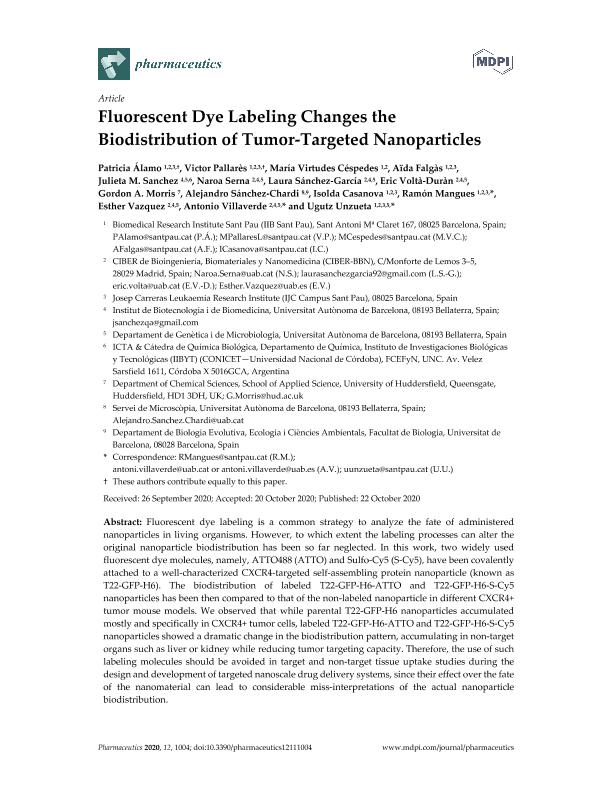Artículo
Fluorescent dye labeling changes the biodistribution of tumor‐targeted nanoparticles
Álamo, Patricia; Pallarès, Victor; Céspedes, María Virtudes; Falgàs, Aïda; Sanchez, Julieta Maria ; Serna, Naroa; Sánchez-García, Laura; Voltà-Duràn, Eric; Morris, Gordon A.; Sánchez-Chardi, Alejandro; Casanova, Isolda; Mangues, Ramón; Vazquez, Esther; Villaverde Corrales, Antonio; Unzueta, Ugutz
; Serna, Naroa; Sánchez-García, Laura; Voltà-Duràn, Eric; Morris, Gordon A.; Sánchez-Chardi, Alejandro; Casanova, Isolda; Mangues, Ramón; Vazquez, Esther; Villaverde Corrales, Antonio; Unzueta, Ugutz
 ; Serna, Naroa; Sánchez-García, Laura; Voltà-Duràn, Eric; Morris, Gordon A.; Sánchez-Chardi, Alejandro; Casanova, Isolda; Mangues, Ramón; Vazquez, Esther; Villaverde Corrales, Antonio; Unzueta, Ugutz
; Serna, Naroa; Sánchez-García, Laura; Voltà-Duràn, Eric; Morris, Gordon A.; Sánchez-Chardi, Alejandro; Casanova, Isolda; Mangues, Ramón; Vazquez, Esther; Villaverde Corrales, Antonio; Unzueta, Ugutz
Fecha de publicación:
11/2020
Editorial:
MDPI AG
Revista:
Pharmaceutics
ISSN:
1999-4923
Idioma:
Inglés
Tipo de recurso:
Artículo publicado
Clasificación temática:
Resumen
Fluorescent dye labeling is a common strategy to analyze the fate of administered nanoparticles in living organisms. However, to which extent the labeling processes can alter the original nanoparticle biodistribution has been so far neglected. In this work, two widely used fluorescent dye molecules, namely, ATTO488 (ATTO) and Sulfo‐Cy5 (S‐Cy5), have been covalently attached to a well‐characterized CXCR4‐targeted self‐assembling protein nanoparticle (known as T22‐GFP‐H6). The biodistribution of labeled T22‐GFP‐H6‐ATTO and T22‐GFP‐H6‐S‐Cy5 nanoparticles has been then compared to that of the non‐labeled nanoparticle in different CXCR4+ tumor mouse models. We observed that while parental T22‐GFP‐H6 nanoparticles accumulated mostly and specifically in CXCR4+ tumor cells, labeled T22‐GFP‐H6‐ATTO and T22‐GFP‐H6‐S‐Cy5 nanoparticles showed a dramatic change in the biodistribution pattern, accumulating in non‐target organs such as liver or kidney while reducing tumor targeting capacity. Therefore, the use of such labeling molecules should be avoided in target and non‐target tissue uptake studies during the design and development of targeted nanoscale drug delivery systems, since their effect over the fate of the nanomaterial can lead to considerable miss‐interpretations of the actual nanoparticle biodistribution.
Archivos asociados
Licencia
Identificadores
Colecciones
Articulos(IIBYT)
Articulos de INSTITUTO DE INVESTIGACIONES BIOLOGICAS Y TECNOLOGICAS
Articulos de INSTITUTO DE INVESTIGACIONES BIOLOGICAS Y TECNOLOGICAS
Citación
Álamo, Patricia; Pallarès, Victor; Céspedes, María Virtudes; Falgàs, Aïda; Sanchez, Julieta Maria; et al.; Fluorescent dye labeling changes the biodistribution of tumor‐targeted nanoparticles; MDPI AG; Pharmaceutics; 12; 11; 11-2020; 1-18
Compartir
Altmétricas



